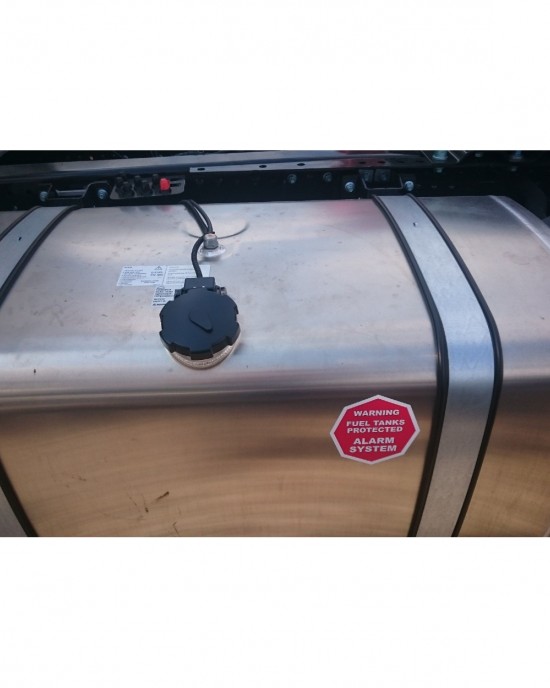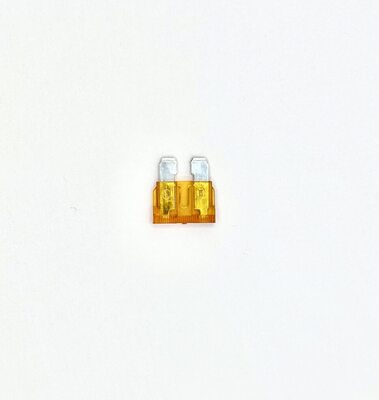Smart Fuel Tank Cap

- Stock status: In Stock
- Model: Smart Fuel Tank Cap
In recent years, transportation companies have increasingly faced the problem of fuel theft from fuel tanks due to rising fuel prices. Typically, theft occurs in two ways:
1) Breaking the fuel tank cap using a wrench

2) Cutting off the protective metal lock

To solve these and other problems, we offer the Smart Fuel Tank Cap

Our Smart Fuel Tank Cap Solution:
The smart fuel tank cap is an effective solution in this situation. It continuously monitors the fuel tank closure and, upon detecting unauthorized access, activates an audible and visual warning signal. If necessary, the system can also transmit a signal to a GPS device, enhancing its effectiveness in preventing fuel theft and deterring intruders.

Main Features
Continuous Monitoring:
The smart fuel tank cap allows for 24/7 monitoring of the fuel tank closure. It uses sensors to detect any attempts to open the tank, ensuring active security against theft.
Audio and Visual Alerts:
Responding to unauthorized access or tampering, the device emits audible alerts such as sirens or beeps, and visual alerts such as LED indicators. These alerts are effective deterrents and help quickly address security breaches.
Compatibility with GPS:
The device is designed to transmit signals to GPS devices. This feature allows for remote monitoring of the fuel tank status, enabling fleet managers and operators to track whether tanks are open or closed, thereby increasing logistics efficiency and safety.
Vandal-Resistant Design:
The smart fuel tank cap is designed to be tamper-proof. It cannot be easily disabled by cutting wires or other means, as it constantly monitors sensor signals. Any deviation in sensor signals triggers a danger signal, ensuring that the device continues to maintain security effectively.
| Model | |
|---|---|
| Package Weight (kg) | 1.6 |
| Dimensions | 230*230*75 mm |
| Power Supply Voltage (V) | 12-36 |
| Maximum Power Supply Voltage (V) | 36 |
| Current Consumption in Safety Mode (mA) | 15 |
| Number of Connected Sensors | 1-4 |
| Additional Input (door sensor) | 1 |
| Siren Control | minus - maximum current 2A |
| Light Control | minus via relay |
| Button with Light and Sound Indication | Yes |
| Maximum Current 12V External (A) | 1.5 |
| Maximum Current 5V External (A) | 0.5 |
| Possibility to Connect to a Tracking Device | Yes |
| Interface | RS232* |
| Sensor Extensions (m) | 4.5 |
| To Siren | autonomous 12V 20W |
1) Microprocessor Control Unit (G1)
Description: The microprocessor control unit, located at the system's core, utilizes advanced microprocessor technology to oversee all system functions. It precisely and efficiently monitors sensors, processes data, and generates danger signals.
Purpose: The primary purpose of the microprocessor control unit is to ensure smooth operation and quick response to security events, meeting strict TAPA security standards designed to protect heavy equipment during transportation.

2) Siren (R1)
Description: The siren is an integral part of the system designed to loudly alert about security breaches or danger signals.
Purpose: The main purpose of the siren is to provide a very loud and attention-grabbing warning signal, ensuring quick response to security incidents.

3) Smart Fuel Tank Cap Sensor
Description: The Smart Fuel Tank Cap sensor is a specialized component integrated into the security device. It is designed to detect the fuel tank closure status and provide key data to the system. This sensor is on the fuel tank cap, ensuring precise monitoring of any unauthorized access or tampering attempts.
Purpose: The main purpose of the smart fuel tank cap sensor is to constantly monitor the fuel tank closure status. It plays a key role in detecting and alerting users to any unauthorized access, ensuring the security of valuable fuel reserves during transportation. Additionally, the sensor contributes to the device's ability to transmit real-time information to the alarm control unit and, if applicable, a GPS device, enabling remote monitoring and enhancing logistics security.

4) Alarm Control Unit with LED Indicators
Description: The alarm control unit with LED indicators is a key system component featuring a convenient interface with LED bulbs. These bulbs indicate various system statuses, allowing operators to easily monitor and control the alarm system.
Purpose: The alarm control unit with LED indicator in the Smart Fuel Tank cap serves a vital purpose – providing real-time feedback and controlling the fuel tank's security status. This allows users to quickly and easily monitor the device's operating mode and sensor status, ensuring the security of valuable fuel reserves during transportation.

5) Cables
Description: Cables are important nodes connecting and transmitting electrical signals between the control unit and heavy equipment sensors of the alarm system.
Purpose: Cable harnesses are responsible for connecting and supplying power to various sensors used in the system, ensuring their accurate operation and data transmission.


6) Emergency (SOS) Button
Description: The emergency (SOS) button located in the driver's cabin is used to immediately call for emergency assistance or activate the alarm system in the event of a roadside accident or other emergency situations requiring protective measures.


7) 5A Fuse
The 5A fuse in the PIN ALARM system is designed to protect the system's electrical components and circuits from potential overloads or short circuits. This safeguards against electronics and equipment damage, ensuring reliable system operation. Upon activation of the 5A fuse, it can be replaced with a new one, maintaining system functionality and ensuring cargo transportation safety.


Operating Principle
Action 1: Data Collection
- The operation begins with specialized sensors strategically placed on fuel tanks, constantly monitoring the state of tank closures.
Action 2: Data Processing
- A special microcomputer receives data from these sensors, collecting real-time information about the fuel tank condition.
Action 3: Data Analysis
- The microcomputer thoroughly analyzes the collected data, carefully examining them to determine the safety status of the fuel tanks.
Action 4: Data Transmission
- After analysis, the microcomputer sends processed data to the remote control panel located in the vehicle's front dashboard.
Action 5: User Interface
- The remote control panel features convenient light-emitting diodes and sound signals that serve as an interface between the system and the driver.
Action 6: Mode Selection
- The driver can comfortably select the desired device operating mode using a button located on the alarm panel.
Activation of Protection
- When the security system is activated, a green light-emitting diode lights up on the remote control panel, visually confirming the system's readiness.
Audio Warnings
- At the same time, the system emits a short beep of the siren, followed by a clear double beep if all sensors are functioning. These audio signals indicate that the alarm is successfully activated in security mode.
Detection of Unauthorized Access
- In the event that any of the sensors detect an attempt to access unlawfully, the alarm system reacts promptly, sending an audio and visual signal.
Shutdown
- It is important to note that the alarm can only be deactivated from within the vehicle, ensuring that it remains protected from tampering.

| Company Code | PC. | Weight per Unit (g) | Description |
|---|---|---|---|
| Alarm Control Unit | |||
| 4622 | 1 | 100 | Alarm Control Unit VIB |
| 2534 | 1 | 4 | Button with Indicator |
| 1 | 86 | Wires with Microchip | |
| Upper Sensor Set for Tank | |||
| 1-4 | 130 | Fuel Tank Sensor | |
| 1-4 | 5 | Magnet | |
| 1-2 | 320 | Fuel Tank Sensor Extension | |
| Mounting Kit | |||
| 1 | 3 | Plastic Bag 200*150mm | |
| 1 | 1 | Fuse 5A | |
| 2944 m | 1 | 5 | Fuse Holder |
| 2-8 | 1 | Screws | |
| 12 | 0.7 | Plastic Clips 200mm | |
| Sound Signal | |||
| 2306? | 1 | 130 | Siren AMPIRE |
| 2306 | 1 | 200 | Autonomous Siren 12V 20W |
| Package | |||
| 1 | 10 | Plastic Bag 200*150mm |
| Thumb | File information |
|
|
Smart Fuel Tank Alarm Installation ENG.pdf File Size1.62MB Downloaded: 0 |
|
|
Smart Fuel Tank Alarm RUS.pdf File Size1.71MB Downloaded: 0 |
